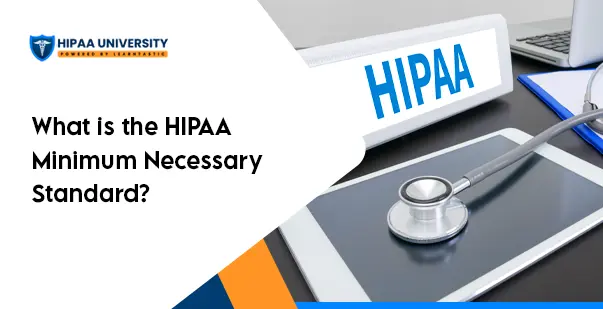What is the HIPAA Minimum Necessary Standard?

September 2, 2024
Did you know that the healthcare industry remains one of the most targeted sectors for data breaches and cyberattacks? Failing to follow the HIPAA Minimum Necessary Standard can result in severe penalties. In fact, violations may cost a healthcare organization $50,000 or more per breach—and in serious cases, over $1.5 million. One of the largest U.S. health data breaches exposed nearly 79 million individuals’ PHI and led to a $16 million fine.
In today’s digital world, healthcare providers have access to vast amounts of patient information. But just because access is possible doesn’t mean it’s always appropriate. That’s where the Minimum Necessary Rule comes in—it helps protect patient privacy by ensuring only the right people access the right data at the right time.
So, what exactly is the HIPAA Minimum Necessary Standard—and how can you make sure your organization complies? Let’s break it down.
What Is HIPAA’s Minimum Necessary Standard?
The Minimum Necessary Standard is a critical provision of the Health Insurance Portability and Accountability Act (HIPAA) that requires covered entities and their business associates to limit the use, disclosure, or request of protected health information (PHI) to only what is necessary to accomplish the intended purpose.
In simpler terms: no one should access more PHI than they need to do their job.
This rule is overseen by the Department of Health and Human Services (HHS) and enforced by the Office for Civil Rights (OCR).
Understanding PHI
Protected Health Information (PHI) refers to any demographic detail that can be used to identify a patient. This includes:
- Names
- Addresses
- Phone numbers
- Social Security Numbers
- Medical records
- Financial details
- Full facial images
Once stored, accessed, or transmitted electronically, PHI becomes Electronic Health Records (EHRs)—and is subject to the same HIPAA rules. Any healthcare organization that touches this information must ensure it’s shared only on a need-to-know basis.
Read More: What is Protected Health Information?
Who Must Follow the HIPAA Minimum Necessary Standard?
This rule applies to two main groups:
1. Covered Entities
These are organizations that collect, create, or transmit PHI electronically. Covered entities include:
- Healthcare providers
- Health insurance companies
- Healthcare clearinghouses
2. Business Associates
A business associate is any third-party service provider that handles PHI while working on behalf of a covered entity. This includes a wide range of vendors and contractors, such as:
- Billing companies
- Practice management firms
- EHR platform providers
- IT service providers
- Fax and shredding services
- Cloud and physical storage companies
- Email hosting platforms
- Legal professionals and attorneys
Whether PHI is being stored, processed, transmitted, or even destroyed, all parties involved must follow HIPAA’s minimum necessary standard.
What Does It Mean to Follow the Minimum Necessary Rule?
Healthcare organizations—whether covered entities or business associates—must build internal policies and procedures that define how much PHI is accessible, who gets access, and under what conditions.
Policies should clarify:
- Who needs access to PHI for their role
- Which types of PHI each role is permitted to access
- Why access is needed and under what circumstances
Example:
Doctors and nurses involved in a patient’s treatment may be granted access to their full medical history. However, if a non-clinical staff member needs to check insurance information, they shouldn’t access unrelated parts of the patient’s record. If full access is given to any non-treatment role, there must be written justification in your internal policies.
How the Minimum Necessary Rule Works in Practice
To comply with HIPAA, organizations must make sure PHI is only accessed when absolutely necessary. Here’s how that plays out operationally:
- PHI Evaluation
Covered entities must review workflows and data access points to determine how much PHI is actually required for each role or task.
- Role-Based Access
Each employee’s job responsibilities should dictate their PHI access level. A radiologist shouldn’t have access to behavioral health notes unless it directly supports their task.
- Unique User IDs
Assign unique login credentials to all users. This allows the organization to monitor access patterns and detect inappropriate usage.
- Audit Controls
Use audit logs to track when and how PHI is accessed. This is vital for identifying unauthorized access and responding to potential data breaches.
- Patient Authorization
With few exceptions, any PHI disclosure outside of treatment, payment, or operations must be authorized by the patient.
By embracing these best practices, healthcare organizations can better protect patient privacy—and dramatically reduce the risk of costly breaches.
How to Comply with the HIPAA Minimum Necessary Standard
While the standard uses the terms “reasonable” and “necessary,” the burden falls on each organization to define these limits based on their specific operations. Here’s how to stay on the right side of HIPAA:
- Conduct a Risk Assessment
Start by identifying how PHI is used, stored, and shared. Pinpoint the potential risks in each workflow and identify where access should be limited.
- Develop Clear Policies
Create documented policies and procedures that specify which roles can access what information. These must be realistic, enforceable, and updated regularly.
- Train the Workforce
Every staff member—from interns to executives—needs to understand HIPAA’s minimum necessary rules. HIPAA training certification ensures everyone knows the “how” and “why” of PHI restrictions.
- Implement Technical Safeguards
Enforce user access controls, permissions, and audit tracking within your software systems. Restrict system access based on job functions.
- Periodic Policy Review
Review internal policies routinely to ensure they’re still effective and reflect any operational changes. This includes updating your workforce training and risk assessments as needed.
- Document Everything
Keep thorough records of your efforts to comply: training logs, audit reports, risk assessments, and policy changes. In case of a HIPAA audit or complaint, this documentation proves your organization is making a good-faith effort to comply.
When Does the HIPAA Minimum Necessary Standard Not Apply?
There are a few exceptions. While these aren’t technically “exemptions,” HIPAA does not apply the minimum necessary rule in the following scenarios:
- When requested by a treating provider
- When requested by the patient
- When shared with the patient’s authorized representative
- When disclosures are authorized in writing by the patient
- For compliance investigations by the Department of Health and Human Services (HHS)
- When required by law
- For disclosures required by the HIPAA transaction rule
In all other cases, you must apply the minimum necessary principle. These exceptions allow for urgent or required communication without unnecessary delays or paperwork.
Who Determines What’s “Minimum Necessary”?
In many cases, the organization disclosing the PHI makes the determination. However, there are times when reliance on another party’s judgment is permitted—as long as that reliance is reasonable.
This includes:
- Other covered entities requesting information
- Public health authorities stating the requested data is minimal and necessary
- Business associates making internal determinations aligned with their contracts
- Researchers submitting proper documentation through a privacy board or IRB
Even in these cases, organizations should review the request and make a good-faith judgment that it aligns with the minimum necessary rule.
Read More: The HIPAA Minimum Necessary Rule Standard
Stay Compliant and Build a Privacy Culture
Privacy and confidentiality aren’t just compliance checkboxes—they’re the cornerstones of quality patient care. Adhering to the HIPAA Minimum Necessary Standard helps you stay compliant year-round and avoid the devastating financial and reputational impact of a breach.
This standard is one piece of a broader framework designed to protect PHI, promote patient safety, and ensure the integrity of the healthcare system. When healthcare teams follow these rules, they build trust, reduce risk, and help ensure HIPAA is more than just a policy—it becomes part of your organization’s culture.





